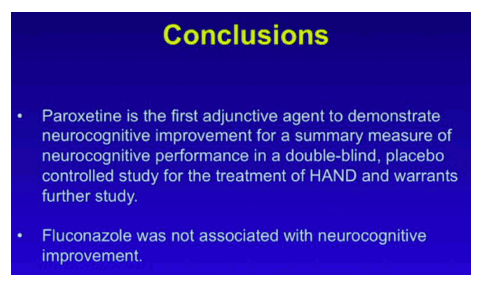 |
 |
 |
| |
Paroxetine and fluconazole therapy for HAND: a double-blind, placebo-controlled trial .....New Brain Treatment: Cognitive Gains With Paroxetine in Randomized Trial of HAND Patients
|
| |
| |
Conference on Retroviruses and Opportunistic Infections (CROI), February 22-25, 2016, Boston
Mark Mascolini
People with HIV-associated neurocognitive disorder (HAND) showed test-measured improvements in cognitive function after 24 weeks of paroxetine in a small double-blind placebo-controlled trial [1]. Cerebrospinal fluid (CSF) lipid markers of oxidative stress did not decline with paroxetine, whereas they did with fluconazole. But people in the fluconazole arms showed no benefit on cognitive tests.
HAND, usually in asymptomatic or mild forms, persists in the HIV population despite virologic response to antiretroviral therapy (ART). Johns Hopkins researchers who conducted this study noted that HAND is linked to persistent central nervous system (CNS) inflammation with macrophage activation and oxidative stress. Paroxetine (an SSRI antidepressant) and fluconazole (an antifungal) demonstrated neuroprotective benefits in macaques [2].
This phase 1/2 placebo-controlled trial enrolled 45 people with HAND and randomized them to one of four groups: (1) 20 mg of paroxetine daily, (2) 100 mg of fluconazole every 12 hours, (3) paroxetine plus fluconazole at those doses, or (4) placebo. Eleven people got assigned to the single-drug or placebo arms and 12 got assigned to paroxetine plus fluconazole.
Participants 18 to 65 years old had to be on stable ART for 3 months. All had neurocognitive impairment indicated by test results that were (1) 1 standard deviation (SD) below age- and education-matched norms on three neuropsychological tests or (2) 2 SD below norms on 1 test and 1 SD below norms on a second test. They could not have a current or past CNS opportunistic infection or current systemic fungal infection.
Age averaged about 50 across study arms, about 75% were women, and about 80% black. Median education stood at about 12 years across arms. Median CD4 counts in the four arms ranged from 461 to 620. Proportions with an undetectable viral load were 86% on paroxetine, 100% on fluconazole, 61% on paroxetine plus fluconazole, and 96% on placebo.
The four treatment groups did not differ in adverse event frequency or laboratory safety measures.
Twenty-four people with better than 90% adherence were included in 24-week as-treated analyses. Participants randomized to paroxetine (alone or with fluconazole) had significantly better cognitive performance as measured by 8 neuropsychological tests (NPZ8 mean change 0.16 versus -0.33 in no-paroxetine arms, P = 0.023) after adjustment for baseline NPZ8 and Beck depression score. The paroxetine arms also did better than the no-paroxetine arms in the CalCAP Sequential Reaction Time test (Z score mean change 0.41 vs 0.06, P = 0.006) after adjustment for baseline CalCAP score and depression.
As-treated analyses also showed that people taking fluconazole (alone or with paroxetine) had a trend toward worse performance on the Global Deficit Score (GDS) when compared with placebo or paroxetine alone (GDS mean change 0.12 versus -0.13, P = 0.051) after adjustment for baseline GDS and depression. The fluconazole arms also did worse than the no-fluconazole arms in the CalCap Choice Reaction Time test, Stroop 1 test, Rey Complex Figure Copy test, and FAS verbal fluency test (P = 0.047, 0.049, 0.037, and 0.047) after adjustment for baseline CalCAP score and depression.
In intention-to-treat analyses participants in the paroxetine arms did better than those in no-paroxetine arms in CalCAP Sequential Reaction Time (P = 0.005) but worse in the Letter Numbering Sequence test (P = 0.028) after adjustment for baseline neuropsychological test scores, depression, and baseline viral load. People randomized to fluconazole showed no neurocognitive test benefits over the no-fluconazole arms in intention-to-treat analyses.
The neurocognitive improvement documented in the paroxetine arms was not linked to decreased CSF lipid markers of oxidative stress. Fluconazole was associated with decreased CSF lipid markers of oxidative stress, but this favorable lab signal did not translate into any improvements in cognitive testing.
The researchers concluded that "paroxetine is the first adjunctive agent to demonstrate neurocognitive improvement for a summary measure of neurocognitive performance in a double-blind, placebo-controlled study for the treatment of HAND and warrants further study."
WEBCAST:http://www.croiwebcasts.org/console/player/29725?mediaType=audio&

References
1. Sacktor N, Skolasky RL, Haughey N, et al. Paroxetine and fluconazole therapy for HAND: a double-blind, placebo-controlled trial. Conference on Retroviruses and Opportunistic Infections (CROI), February 22-25, 2016, Boston. Abstract 146.
2. Meulendyke KA, Queen SE, Engle EL, et al. Combination fluconazole/paroxetine treatment is neuroprotective despite ongoing neuroinflammation and viral replication in an SIV model of HIV neurological disease. J Neurovirol. 2014;20:591-602. http://www.ncbi.nlm.nih.gov/pmc/articles/PMC4267991/
|
| |
|
 |
 |
|
|